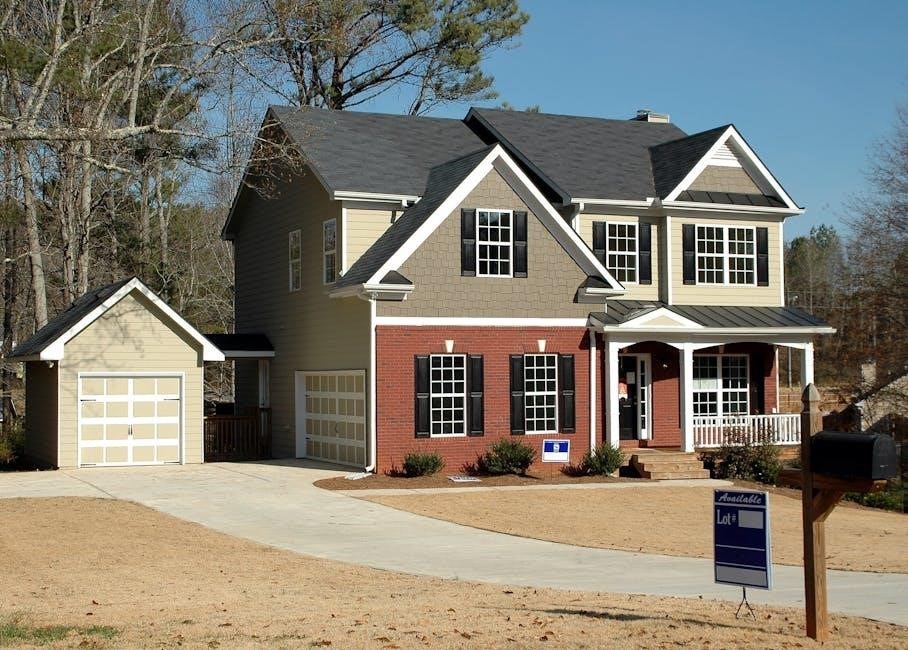
Pierce County egress requirements ensure safe exits in emergencies, with specific codes for window size, emergency escape openings, and proper lighting. Compliance is critical for safety and legal approval.
Overview of Egress Codes
Pierce County egress codes establish standards for safe emergency exits in residential and commercial buildings. These codes ensure adequate escape routes, proper window and door sizes, and clear pathways. They also specify requirements for exit signs, lighting, and stairway dimensions. Compliance with these regulations is crucial for occupant safety and legal approval. The codes are designed to prevent hazards and provide reliable means of egress in emergencies, ensuring all buildings meet minimum safety standards.
Importance of Compliance
Compliance with Pierce County egress codes is vital for ensuring occupant safety, preventing hazards, and meeting legal standards. Proper egress pathways and emergency exits can save lives during fires or other emergencies. Non-compliance may result in fines, permit denial, or unsafe living conditions. Adhering to these regulations ensures buildings are structurally sound and provide reliable escape routes, safeguarding residents and visitors alike. Compliance also avoids legal penalties and ensures smooth permitting processes for construction projects.

Egress Requirements for Windows
Pierce County mandates windows meet specific size and area requirements for emergency egress. Each window must provide at least 5.7 sq. ft. of net clear opening, with a minimum height and width of 24 inches and 20 inches, respectively. This ensures safe escape routes and compliance with local building codes for two-story houses.
Minimum Window Size and Area
Pierce County requires egress windows to meet specific size and area standards. Each window must provide a minimum net clear opening of 5.7 square feet, with at least 24 inches in height and 20 inches in width. These dimensions ensure safe and easy escape during emergencies. For two-story houses, windows must also maintain proper proportions to allow unobstructed exit routes. Compliance with these measurements is crucial for safety and to satisfy local building codes and regulations.
Window Well Requirements
Pierce County mandates specific window well requirements for safe egress. Window wells deeper than 44 inches must have a permanent ladder or steps. The well must have a minimum horizontal projection of 36 inches and a width of at least 36 inches. These specifications ensure easy access and emergency escape. Proper drainage and structural integrity are also required to prevent hazards. Compliance with these standards is essential for safety and to meet local building codes and regulations effectively.
Emergency Escape and Rescue Openings
Emergency escape and rescue openings must meet specific Pierce County codes. These openings, such as windows, must provide at least 9 square feet of area with a minimum width of 36 inches. They must be operational without tools and allow for easy access. Proper drainage and structural support are required to ensure functionality. These openings are critical for safe evacuation and rescue operations, especially in below-grade spaces like basements. Compliance ensures both safety and adherence to local building regulations.

Egress Requirements for Doors
Doors must meet specific size and swing requirements for safe egress. Minimum door size and clear width ensure easy passage, while proper swing direction and threshold height enhance accessibility and safety.
Minimum Door Size and Clear Width
Doors serving as egress points must meet specific size requirements to ensure safe and unobstructed exit routes. The minimum door width is typically 32 inches, with a height of 78 inches. Clear width, measured as the narrowest point in the doorway, must be at least 31.5 inches to accommodate easy passage. These standards ensure doors provide adequate space for individuals to exit quickly, especially in emergency situations, while also meeting accessibility standards for all users.
Swing and Threshold Requirements
Doors must swing in the direction of egress travel, ensuring unobstructed exit routes. For basement egress, doors are required to swing outward to prevent interference with escape paths. Thresholds must be designed to allow easy passage, with a maximum height of 1.5 inches to facilitate smooth transition. These requirements ensure doors operate efficiently during emergencies, providing safe and accessible exits for all occupants while adhering to Pierce County building codes.

Emergency Escape Routes
Pierce County requires clear, accessible escape routes, with exits marked properly and maintained for quick evacuation. Two-story homes need at least two exits, one on each level.
Number of Required Exits
Pierce County mandates at least two exits for two-story homes, one on each level, ensuring safe evacuation. Basements require a separate egress point, either a window or door. Exits must be accessible, with clear paths and proper signage. Compliance with local building codes ensures safety and legal approval, preventing hazards during emergencies. Proper exit placement and visibility are critical for quick evacuation, especially in multi-level structures. Always verify with current codes for specific requirements. Safety is paramount in all designs.
Placement and Accessibility
Exits must be centrally located and accessible without obstruction. Clear paths must remain unblocked, ensuring easy evacuation. Lighting along egress routes is essential for visibility. Exit signs are required at stair enclosures when multiple exits exist. Basement egress windows must be accessible with ladders or steps. Accessibility standards ensure all exits meet minimum clear width and height requirements, aligning with Pierce County building codes for safety and compliance. Proper placement enhances emergency response efficiency and safety for all occupants. Always adhere to local regulations for optimal safety.
Provisions for Two-Story Houses
Two-story houses in Pierce County must have at least one exit on each level, with clear access to exterior doors or windows. Basements require egress windows or doors meeting size and well specifications. Stairways must comply with tread depth and handrail requirements. Escape routes should remain unobstructed, and exit signs must be visible. Proper lighting along pathways ensures safe evacuation. These provisions align with local building codes to enhance safety and facilitate quick emergency response for all occupants. Compliance is essential for both upper and lower levels. Always verify with local regulations for specific requirements. Proper placement of exits ensures efficiency in emergency situations. Accessibility standards must be maintained throughout the structure to ensure safe evacuation routes. Clear visibility and proper signage are critical for navigating stairways and exits during emergencies. Regular inspections ensure compliance with Pierce County codes, promoting a safe living environment. Properly designed egress systems prevent accidents and delays during evacuations. All exits must meet minimum width and height requirements to accommodate easy passage. Emergency escape routes should remain well-lit and free from obstacles. Properly installed handrails and guardrails enhance safety on stairways. Compliance with these provisions is vital for the safety of all residents. Always consult local building codes for detailed specifications and requirements. Properly designed egress systems ensure quick and safe evacuations in emergency situations. Clear signage and adequate lighting are essential for navigating exit routes. Regular maintenance of egress systems ensures ongoing compliance and safety. Properly installed exits and pathways prevent accidents and delays during evacuations. All egress routes must remain accessible and visible at all times. Compliance with Pierce County codes ensures a safe and efficient evacuation process. Properly designed systems enhance the overall safety of the structure. Always adhere to local regulations for optimal safety and legal compliance. Properly installed exits and pathways ensure quick and safe evacuations in emergency situations. Clear signage and adequate lighting are essential for navigating exit routes. Regular maintenance of egress systems ensures ongoing compliance and safety. Properly installed exits and pathways prevent accidents and delays during evacuations. All egress routes must remain accessible and visible at all times. Compliance with Pierce County codes ensures a safe and efficient evacuation process. Properly designed systems enhance the overall safety of the structure. Always adhere to local regulations for optimal safety and legal compliance. Properly installed exits and pathways ensure quick and safe evacuations in emergency situations. Clear signage and adequate lighting are essential for navigating exit routes. Regular maintenance of egress systems ensures ongoing compliance and safety. Properly installed exits and pathways prevent accidents and delays during evacuations. All egress routes must remain accessible and visible at all times. Compliance with Pierce County codes ensures a safe and efficient evacuation process. Properly designed systems enhance the overall safety of the structure. Always adhere to local regulations for optimal safety and legal compliance.

Stairway and Landing Requirements
Stairways must meet specific tread depth, riser height, and handrail requirements. Landings should be at least 36 inches wide and accommodate safe passage for emergencies.
Stair Dimensions and Tread Depth
Stairways in Pierce County must adhere to specific dimensional requirements for safety. Treads must be at least 10 inches deep, and risers should not exceed 8.25 inches in height. The nosing, if present, must protrude at least 0;75 inches beyond the tread. Landings are required at the top and bottom of stairways, with a minimum width of 36 inches. These specifications ensure safe and functional passage, especially in two-story homes, aligning with local building codes and egress standards.
Handrail and Guardrail Specifications
Pierce County requires handrails on both sides of stairways, with a graspable profile and a height between 34 and 38 inches. Guardrails are mandatory for landings and stairways exceeding 30 inches in height, also at 34 to 38 inches tall. Continuous handrails must be provided without interruption, ensuring safe navigation. These specifications align with safety standards, preventing falls and ensuring accessibility in two-story homes, as outlined in local building codes and egress requirements.

Exit Signs and Lighting
Exit signs are required at stair enclosures when multiple exits are needed. Lighting must maintain at least 1 foot-candle of illumination along the egress path for safety.
Exit Sign Installation
Exit signs must be installed at stair enclosure doors when multiple exits are required. They should be visible, illuminated, and comply with Tacoma-Pierce County Health standards. Signs must clearly display “EXIT” in 6-inch-high letters and include arrows if direction is needed. Illumination can be electric or self-luminous, maintaining at least 5 foot-candles. Proper installation ensures clear guidance during emergencies, especially in multi-level homes, enhancing safety and meeting local building codes effectively.
Lighting Requirements for Egress Paths
Egress paths must maintain a minimum illumination of 5 foot-candles at floor level. Emergency lighting, if required, should provide 90 minutes of battery backup. Fixtures must be tamper-proof and spaced to ensure even lighting. Illumination levels must not drop below 1 foot-candle at any point. Regular testing of emergency lighting systems is mandatory to ensure reliability. These standards ensure safe navigation during emergencies, particularly in multi-story homes, aligning with Pierce County’s safety regulations.

Basement and Crawl Space Egress
Basements and crawl spaces require egress windows with a minimum area of 9 sq. ft. and 36″ width. Window wells deeper than 44″ need ladders. Doors for below-grade spaces must meet specific size and accessibility standards to ensure safe emergency exits.
Egress Windows for Basements
Pierce County requires basement egress windows to have a minimum area of 9 square feet, with a minimum width of 36 inches and height of 24 inches. These windows must provide a safe escape route and allow for emergency rescue. Window wells deeper than 44 inches must include a permanently attached ladder. The well must project at least 36 inches horizontally from the window. Proper drainage is also essential to ensure functionality and safety.
Doors and Emergency Exits for Below-Grade Spaces
For below-grade spaces, Pierce County mandates that doors serving as emergency exits must have a clear width of at least 32 inches. These doors must swing outward and be free from obstructions. Emergency exits must lead directly to an exterior courtyard or yard, providing a clear path to safety. All such exits must comply with local building codes to ensure quick and safe evacuation during emergencies.

Fire Safety and Egress
Pierce County codes emphasize fire safety through proper egress routes, exit signs, and emergency lighting. These measures ensure safe evacuation during fires, protecting occupants effectively.
Smoke Detectors and Alarms
Smoke detectors are essential for early fire detection, requiring installation on every level and in sleeping areas. Hardwired, interconnected systems are mandated for new constructions. Testing must occur quarterly, with replacements every 10 years. These requirements ensure timely alerts, aiding safe evacuation and compliance with Pierce County egress codes. Proper maintenance is crucial for reliability, safeguarding occupants during emergencies. Adherence to these standards is vital for preventing fire-related hazards and ensuring a swift, safe exit.
Fire Extinguisher Placement
Fire extinguishers must be installed on every level of a two-story house, including basements and garages. They should be easily accessible, with at least one located in the kitchen. Extinguishers must be rated for common household fires and mounted on walls at a height of 3.5 to 5 feet. Inspections are required annually, ensuring they are fully charged and operational. Proper placement enhances fire safety, aligning with Pierce County egress and fire codes to protect occupants and facilitate quick responses during emergencies.

Inspections and Permits
All construction must pass inspections, ensuring compliance with Pierce County egress codes. Permits are required for new builds or modifications, guaranteeing safety and code adherence.
Inspection Requirements
Inspections ensure compliance with Pierce County egress codes, focusing on windows, doors, and emergency escape routes. All structures must meet Title 18E Development Regulations. Inspections verify proper installation of egress windows, doors, and emergency exits, ensuring they meet minimum size and accessibility standards. The Building Department conducts these inspections to guarantee safety and code adherence. Non-compliance can result in permit denial or required modifications. Regular inspections are crucial for maintaining safety standards in both new constructions and existing buildings.
Permitting Process
The permitting process in Pierce County ensures compliance with egress codes. Homeowners must submit detailed plans for egress windows, doors, and emergency exits. A site plan is required, outlining the property layout and proposed construction. Local authorities review these plans to verify adherence to Title 18E Development Regulations. Permits are issued only after compliance with specific egress codes. The Tacoma-Pierce County Health Department may also require approvals. A compliant site plan is essential for obtaining necessary permits and avoiding delays in construction.
Pierce County egress codes ensure safety and legal compliance, requiring proper emergency exits and lighting. Adherence to these regulations is crucial for protecting residents and avoiding penalties.
Pierce County egress codes mandate minimum window sizes, emergency escape openings, and proper exit signage. Window wells must meet size and accessibility standards, while doors require clear width and proper swing. Exit routes must be well-lit and accessible, with specific provisions for two-story homes. Compliance ensures safety, legal approval, and adherence to local building codes, promoting safe evacuation and preventing hazards. These requirements align with county development regulations and public safety goals.
Resources for Compliance
Homeowners and builders can access Pierce County egress requirements through the official county code publications, specifically Title 18E Development Regulations. The Tacoma-Pierce County Health Department provides additional guidelines. Online resources include the Pierce County website and municipal code databases. Site plans, building permits, and inspection checklists are also available. These resources ensure adherence to safety standards and legal requirements, aiding in compliance with egress codes for two-story houses and other structures within Pierce County.